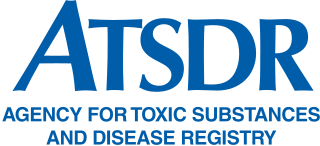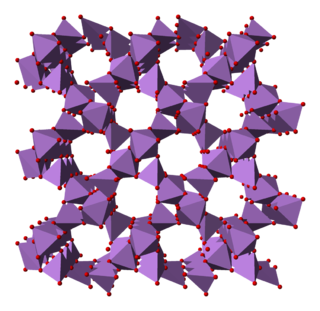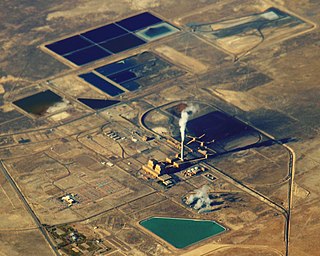
Hazardous waste is waste that has substantial or potential threats to public health or the environment. Hazardous waste is a type of dangerous goods. They usually have one or more of the following hazardous traits: ignitability, reactivity, corrosivity, toxicity. Listed hazardous wastes are materials specifically listed by regulatory authorities as hazardous wastes which are from non-specific sources, specific sources, or discarded chemical products. Hazardous wastes may be found in different physical states such as gaseous, liquids, or solids. A hazardous waste is a special type of waste because it cannot be disposed of by common means like other by-products of our everyday lives. Depending on the physical state of the waste, treatment and solidification processes might be required.

Nickel carbonyl (IUPAC name: tetracarbonylnickel) is a nickel(0) organometallic compound with the formula Ni(CO)4. This colorless liquid is the principal carbonyl of nickel. It is an intermediate in the Mond process for producing very high-purity nickel and a reagent in organometallic chemistry, although the Mond Process has fallen out of common usage due to the health hazards in working with the compound. Nickel carbonyl is one of the most dangerous substances yet encountered in nickel chemistry due to its very high toxicity, compounded with high volatility and rapid skin absorption.

Nitrogen dioxide is a chemical compound with the formula NO2. It is one of several nitrogen oxides. NO
2 is an intermediate in the industrial synthesis of nitric acid, millions of tons of which are produced each year for use primarily in the production of fertilizers. At higher temperatures it is a reddish-brown gas. It can be fatal if inhaled in large quantities. Nitrogen dioxide is a paramagnetic, bent molecule with C2v point group symmetry.

The Agency for Toxic Substances and Disease Registry (ATSDR) is a federal public health agency within the United States Department of Health and Human Services. The agency focuses on minimizing human health risks associated with exposure to hazardous substances. It works closely with other federal, state, and local agencies; tribal governments; local communities; and healthcare providers. Its mission is to "Serve the public through responsive public health actions to promote healthy and safe environments and prevent harmful exposures." ATSDR was created as an advisory, nonregulatory agency by the Superfund legislation and was formally organized in 1985.

Bioremediation broadly refers to any process wherein a biological system, living or dead, is employed for removing environmental pollutants from air, water, soil, flue gasses, industrial effluents etc., in natural or artificial settings. The natural ability of organisms to adsorb, accumulate, and degrade common and emerging pollutants has attracted the use of biological resources in treatment of contaminated environment. In comparison to conventional physicochemical treatment methods bioremediation may offer considerable advantages as it aims to be sustainable, eco-friendly, cheap, and scalable. Most bioremediation is inadvertent, involving native organisms. Research on bioremediation is heavily focused on stimulating the process by inoculation of a polluted site with organisms or supplying nutrients to promote the growth. In principle, bioremediation could be used to reduce the impact of byproducts created from anthropogenic activities, such as industrialization and agricultural processes. Bioremediation could prove less expensive and more sustainable than other remediation alternatives.
Carbachol, also known as carbamylcholine and sold under the brand name Miostat among others, is a cholinomimetic drug that binds and activates acetylcholine receptors. Thus it is classified as a cholinergic agonist. It is primarily used for various ophthalmic purposes, such as for treating glaucoma, or for use during ophthalmic surgery. It is generally administered as an ophthalmic solution.

Occupational hygiene is the anticipation, recognition, evaluation, control, and confirmation (ARECC) of protection from risks associated with exposures to hazards in, or arising from, the workplace that may result in injury, illness, impairment, or affect the well-being of workers and members of the community. These hazards or stressors are typically divided into the categories biological, chemical, physical, ergonomic and psychosocial. The risk of a health effect from a given stressor is a function of the hazard multiplied by the exposure to the individual or group. For chemicals, the hazard can be understood by the dose response profile most often based on toxicological studies or models. Occupational hygienists work closely with toxicologists for understanding chemical hazards, physicists for physical hazards, and physicians and microbiologists for biological hazards. Environmental and occupational hygienists are considered experts in exposure science and exposure risk management. Depending on an individual's type of job, a hygienist will apply their exposure science expertise for the protection of workers, consumers and/or communities.

A hazmat suit is a piece of personal protective equipment that consists of an impermeable whole-body garment worn as protection against hazardous materials.

An environmental hazard is a substance, state or event which has the potential to threaten the surrounding natural environment or adversely affect people's health, including pollution and natural disasters such as storms and earthquakes. It can include any single or combination of toxic chemical, biological, or physical agents in the environment, resulting from human activities or natural processes, that may impact the health of exposed subjects, including pollutants such as heavy metals, pesticides, biological contaminants, toxic waste, industrial and home chemicals.

Aldrin is an organochlorine insecticide that was widely used until the 1990s, when it was banned in most countries. Aldrin is a member of the so-called "classic organochlorines" (COC) group of pesticides. COCs enjoyed a very sharp rise in popularity during and after The Second World War. Other noteworthy examples of COCs include DDT. After research showed that organochlorines can be highly toxic to the ecosystem through bioaccumulation, most were banned from use. Before the ban, it was heavily used as a pesticide to treat seed and soil. Aldrin and related "cyclodiene" pesticides became notorious as persistent organic pollutants.
Diving disorders, or diving related medical conditions, are conditions associated with underwater diving, and include both conditions unique to underwater diving, and those that also occur during other activities. This second group further divides into conditions caused by exposure to ambient pressures significantly different from surface atmospheric pressure, and a range of conditions caused by general environment and equipment associated with diving activities.

Menadione is a natural organic compound with the formula C6H4(CO)2C2H(CH3). It is an analog of 1,4-naphthoquinone with a methyl group in the 2-position. It is sometimes called vitamin K3. Use is allowed as a nutritional supplement in animal feed because of its vitamin K activity.

Antimycin A is a secondary metabolite produced by Streptomyces bacteria and a member of a group of related compounds called antimycins. Antimycin A is classified as an extremely hazardous substance in the United States, as defined in Section 302 of the U.S. Emergency Planning and Community Right-to-Know Act, and is subject to strict reporting requirements by facilities which produce, store, or use it in significant quantities.

Arsenic pentoxide is the inorganic compound with the formula As2O5. This glassy, white, deliquescent solid is relatively unstable, consistent with the rarity of the As(V) oxidation state. More common, and far more important commercially, is arsenic(III) oxide (As2O3). All inorganic arsenic compounds are highly toxic and thus find only limited commercial applications.
Astronautical hygiene evaluates, and mitigates, hazards and health risks to those working in low-gravity environments. The discipline of astronautical hygiene includes such topics as the use and maintenance of life support systems, the risks of the extravehicular activity, the risks of exposure to chemicals or radiation, the characterization of hazards, human factor issues, and the development of risk management strategies. Astronautical hygiene works side by side with space medicine to ensure that astronauts are healthy and safe when working in space.

The environmental effects of paint can vary depending on the type of paint used and mitigation measures. Traditional painting materials and processes can have harmful effects on the environment, including those from the use of lead and other additives. Measures can be taken to reduce its environmental effects, including accurately estimating paint quantities so waste is minimized, and use of environmentally preferred paints, coating, painting accessories, and techniques.
Chromium toxicity refers to any poisonous toxic effect in an organism or cell that results from exposure to specific forms of chromium—especially hexavalent chromium. Hexavalent chromium and its compounds are toxic when inhaled or ingested. Trivalent chromium is a trace mineral that is essential to human nutrition. There is a hypothetical risk of genotoxicity in humans if large amounts of trivalent chromium were somehow able to enter living cells, but normal metabolism and cell function prevent this.

An orinasal mask, oro-nasal mask or oral-nasal mask is a breathing mask that covers the mouth and the nose only. It may be a complete independent item, as an oxygen mask, or on some anaesthetic apparatuses, or it may be fitted as a component inside a fullface mask on underwater breathing apparatus, a gas mask or an industrial respirator to reduce the amount of dead space. It may be designed for its lower edge to seal on the front of the lower jaw or to go under the chin.

Coal ash, also known as coal combustion residuals (CCRs), is the mineral residue that remains from burning coal. Exposure to coal ash and to the toxic substances it contains may pose a health risk to workers in coal-fired power plants and residents living near coal ash disposal sites.















